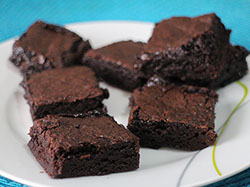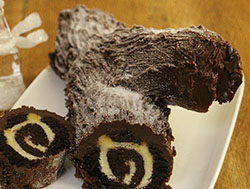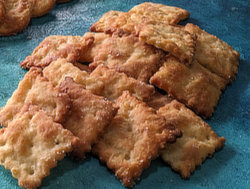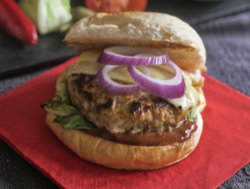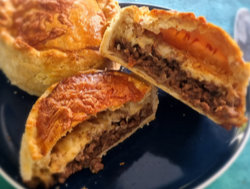
Gingerbread House
Introduction & method
A gingerbread house can be a fun thing to make. It can also be torture, because if you haven't had a lot of practise at gingerbread housemaking, many things can go wrong.
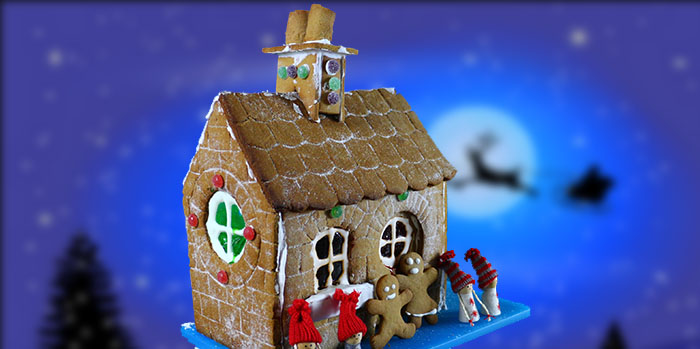
Think About Design
Before you start, you need to think about what you want your gingerbread house to look like. The most basic design requires 4 walls, 2 roof slabs, and a door. You might also want to add a chimney, which will require 4 sides (2 of them with inverted Vs cut in them so they'll fit on the roof), a top slab and a chimney pot. Make a rough sketch of it and mark on the main dimensions. Mine was 24cm (91⁄2 inches) x 16cm (61⁄4 inches). The front and back walls were 16cm (61⁄4 inches) high, and the gable ends reached to 26cm (101⁄4). If you aren't confident about 3D geometry, you might want to make paper templates for each piece.
Make the Gingerbread
Preheat your oven to 180°C (356°F) if it's a fan oven, or 200°C (392°F) for a conventional oven. On a low heat, melt together the butter, sugar and syrup and cook together for about 5 minutes until they are completely amalgamated. In a large bowl, mix the flour, bicarb and ginger. Stir in the liquid mixture, give it a good mix, then tip it out onto your worktop and knead it until you have quite a stiff dough. Wrap it in plastic film, and put in the fridge until cool.
Make your Slabs
When the dough is cool, sprinkle flour on your worktop and roll out the pieces you need for each part of the house. Cut them to size, and also cut any doors and windows you need. Bake them for 10-12 minutes. The baked pieces should feel firm when you poke them. Let them cool a little, and then trim the edges using a sharp knife and a ruler. Let the slabs cool completely before you attempt to assemble them.
Make Your Mortar - Royal Icing
You'll need royal icing to use as the glue for your pieces. With an electric whisk or stand mixer, beat the egg whites until they are frothy, then add half the sugar and beat until well-combined. Turn up the speed and slowly add more sugar, and continue whisking until the mixture reaches the stiff peaks stage.
Make Sugar Glass
This is entirely optional, but if you want glass in your windows - possibly coloured, this is how you do it. Melt together the sugar, water and cream of tartar, and heat until the temperature reaches 150°C (302°F). This is known in the world of sugar as the 'hard crack' stage. To test if you've hit it, drop some of the mixture into a glass of cold water - it will solidify instantly into brittle threads. You can now pour some of the mixture into your window openings - make sure you have some greaseproof paper under them, or the sugar glass will stick to the tray. Alternatively, you can make sheets of sugar glass by pouring it into a baking sheet lined with greaseproof paper, and then cut the sheet to size and stick it in place with royal icing.
Begin Assembly
It's best to do the assembly in stages, possibly over a day or two, to make sure the icing has hardened before you ask it to bear any weight. It's also a good idea to stick on things like window sills, and pipe glazing bars onto your windows while the elements are horizontal.
TIP
I stuck some bars of gingerbread onto the back of my roof panels, near the bottom, to stop the roof pieces from sliding down. Begin assembly by gluing the four walls together. You'll probably need lots of things to prop them up while waiting for the icing to set - this is a good use for cookbooks.Assemble the chimney, if you're having one.
Finally...
Stick the roof and the chimney on, decorate in whatever way you wish. Merry Christmas! Your gingerbread house likely won't last long - depending on humidity levels, maybe only a day or two. It's best not to keep it in your hot, steamy kitchen, because both sugar and egg-whites are hygroscopic and will absorb moisture from the air.
The video above is from the Keef Cooks YouTube channel. Click here to see the video recipe of Gingerbread House on YouTube.
Related recipes from Keef Cooks
You might also like these recipes:
Ingredients & Info
GINGERBREAD
 375 grams unsalted butter
375 grams unsalted butter 300 grams dark muscovado sugar
300 grams dark muscovado sugar  150 grams golden syrup
150 grams golden syrup 900 grams plain (all-purpose) flour
900 grams plain (all-purpose) flour 1 tsp bicarbonate of soda
1 tsp bicarbonate of soda 2 tbsp powdered ginger
2 tbsp powdered ginger ROYAL ICING
ROYAL ICING 2 egg whitess
2 egg whitess 300 grams caster (powdered) sugar
300 grams caster (powdered) sugar SUGAR GLASS
SUGAR GLASS 240 grams caster (powdered) sugar
240 grams caster (powdered) sugar 240 ml water
240 ml water 1 sachet cream of tartar
1 sachet cream of tartarPLUS
Jelly sweets and other bits of frippery for decoration.
Makes 1 Gingerbread House
Prep time: 30 minutes.
assembly time: 1 day.
Cooking time: 12 minutes.
Total time: 1 day 42 minutes.
Prep time: 30 minutes.
assembly time: 1 day.
Cooking time: 12 minutes.
Total time: 1 day 42 minutes.
